Impact of IFRS on Property Valuation
VerifiedAdded on 2020/03/23
|11
|3799
|305
AI Summary
This assignment examines the influence of International Financial Reporting Standards (IFRS) on the accounting treatment of property, plant, and equipment (PP&E). It delves into the implications of IFRS for fair value measurements of PP&E, particularly focusing on real estate. Additionally, the assignment analyzes the impact of IFRS lease accounting standards on financial reporting related to property leases. It utilizes a mix of academic literature, regulatory pronouncements, and real-world examples to illustrate the key changes brought about by IFRS in this domain.
Contribute Materials
Your contribution can guide someone’s learning journey. Share your
documents today.
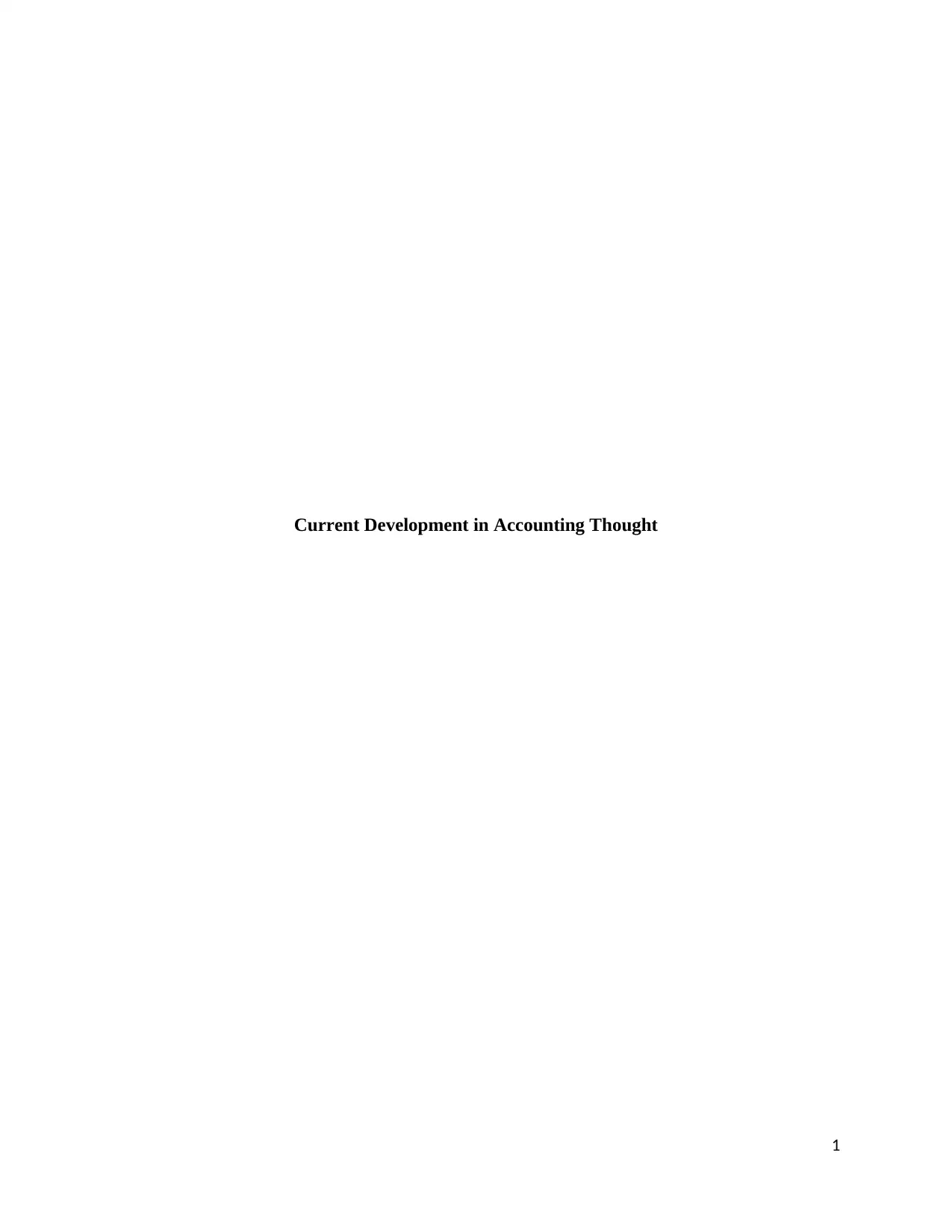
Current Development in Accounting Thought
1
1
Secure Best Marks with AI Grader
Need help grading? Try our AI Grader for instant feedback on your assignments.
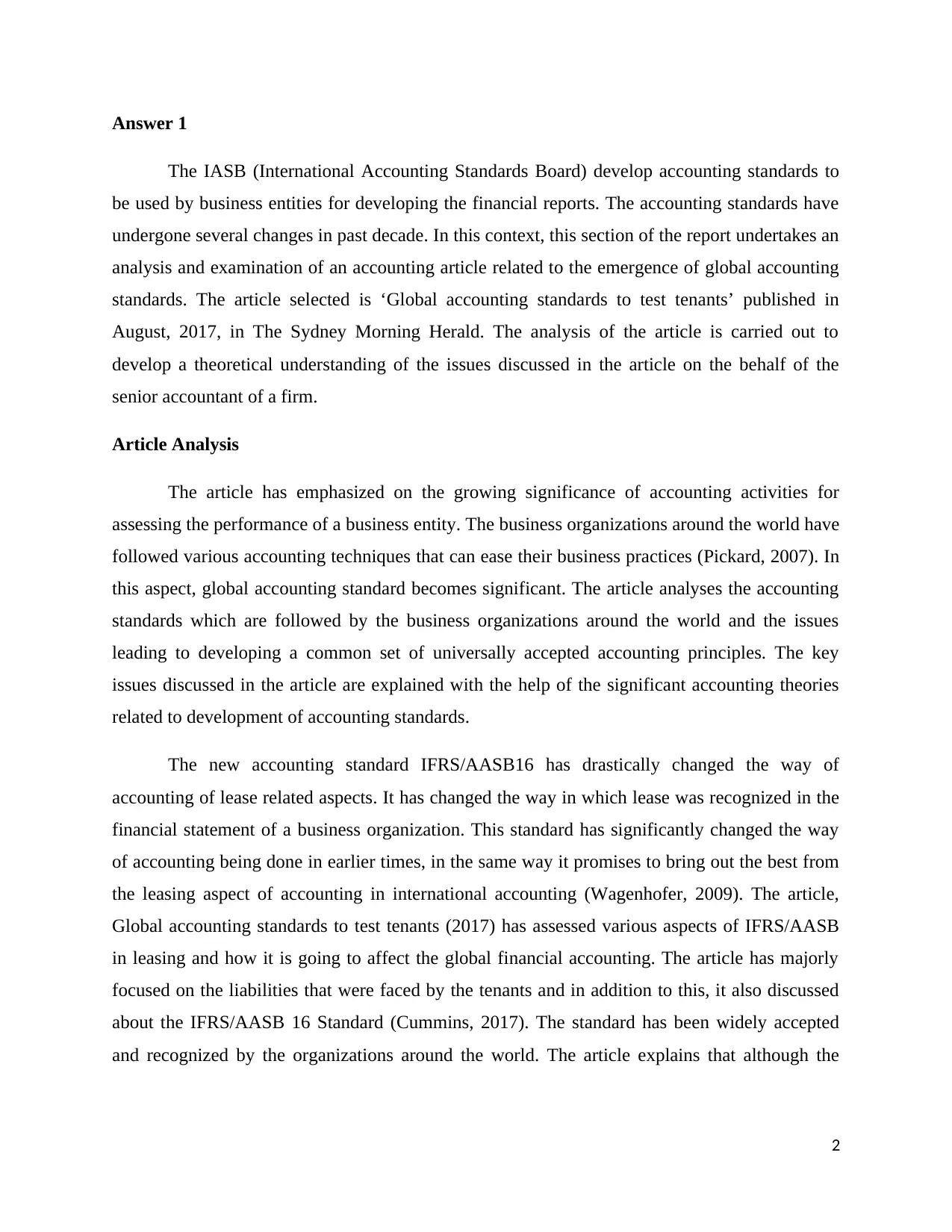
Answer 1
The IASB (International Accounting Standards Board) develop accounting standards to
be used by business entities for developing the financial reports. The accounting standards have
undergone several changes in past decade. In this context, this section of the report undertakes an
analysis and examination of an accounting article related to the emergence of global accounting
standards. The article selected is ‘Global accounting standards to test tenants’ published in
August, 2017, in The Sydney Morning Herald. The analysis of the article is carried out to
develop a theoretical understanding of the issues discussed in the article on the behalf of the
senior accountant of a firm.
Article Analysis
The article has emphasized on the growing significance of accounting activities for
assessing the performance of a business entity. The business organizations around the world have
followed various accounting techniques that can ease their business practices (Pickard, 2007). In
this aspect, global accounting standard becomes significant. The article analyses the accounting
standards which are followed by the business organizations around the world and the issues
leading to developing a common set of universally accepted accounting principles. The key
issues discussed in the article are explained with the help of the significant accounting theories
related to development of accounting standards.
The new accounting standard IFRS/AASB16 has drastically changed the way of
accounting of lease related aspects. It has changed the way in which lease was recognized in the
financial statement of a business organization. This standard has significantly changed the way
of accounting being done in earlier times, in the same way it promises to bring out the best from
the leasing aspect of accounting in international accounting (Wagenhofer, 2009). The article,
Global accounting standards to test tenants (2017) has assessed various aspects of IFRS/AASB
in leasing and how it is going to affect the global financial accounting. The article has majorly
focused on the liabilities that were faced by the tenants and in addition to this, it also discussed
about the IFRS/AASB 16 Standard (Cummins, 2017). The standard has been widely accepted
and recognized by the organizations around the world. The article explains that although the
2
The IASB (International Accounting Standards Board) develop accounting standards to
be used by business entities for developing the financial reports. The accounting standards have
undergone several changes in past decade. In this context, this section of the report undertakes an
analysis and examination of an accounting article related to the emergence of global accounting
standards. The article selected is ‘Global accounting standards to test tenants’ published in
August, 2017, in The Sydney Morning Herald. The analysis of the article is carried out to
develop a theoretical understanding of the issues discussed in the article on the behalf of the
senior accountant of a firm.
Article Analysis
The article has emphasized on the growing significance of accounting activities for
assessing the performance of a business entity. The business organizations around the world have
followed various accounting techniques that can ease their business practices (Pickard, 2007). In
this aspect, global accounting standard becomes significant. The article analyses the accounting
standards which are followed by the business organizations around the world and the issues
leading to developing a common set of universally accepted accounting principles. The key
issues discussed in the article are explained with the help of the significant accounting theories
related to development of accounting standards.
The new accounting standard IFRS/AASB16 has drastically changed the way of
accounting of lease related aspects. It has changed the way in which lease was recognized in the
financial statement of a business organization. This standard has significantly changed the way
of accounting being done in earlier times, in the same way it promises to bring out the best from
the leasing aspect of accounting in international accounting (Wagenhofer, 2009). The article,
Global accounting standards to test tenants (2017) has assessed various aspects of IFRS/AASB
in leasing and how it is going to affect the global financial accounting. The article has majorly
focused on the liabilities that were faced by the tenants and in addition to this, it also discussed
about the IFRS/AASB 16 Standard (Cummins, 2017). The standard has been widely accepted
and recognized by the organizations around the world. The article explains that although the
2
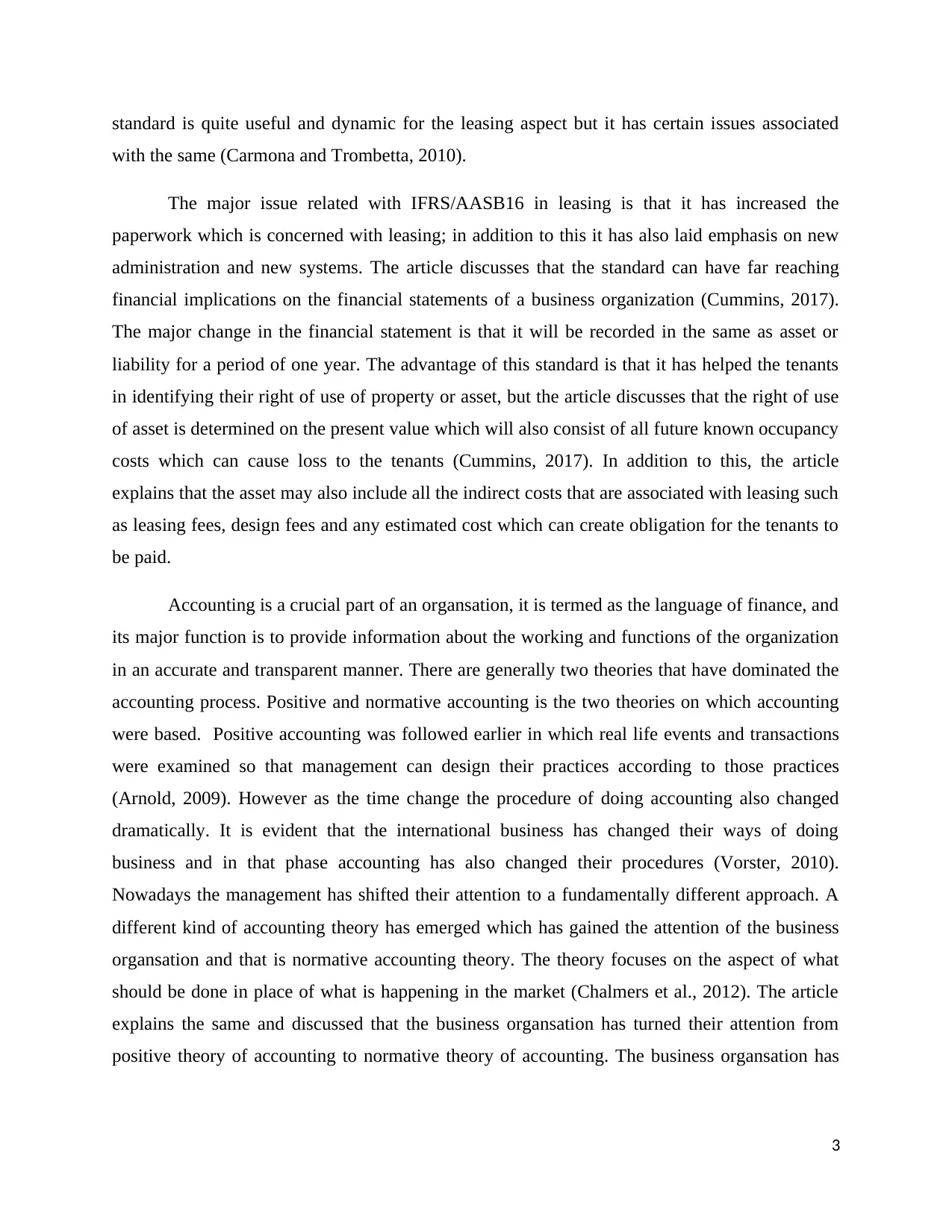
standard is quite useful and dynamic for the leasing aspect but it has certain issues associated
with the same (Carmona and Trombetta, 2010).
The major issue related with IFRS/AASB16 in leasing is that it has increased the
paperwork which is concerned with leasing; in addition to this it has also laid emphasis on new
administration and new systems. The article discusses that the standard can have far reaching
financial implications on the financial statements of a business organization (Cummins, 2017).
The major change in the financial statement is that it will be recorded in the same as asset or
liability for a period of one year. The advantage of this standard is that it has helped the tenants
in identifying their right of use of property or asset, but the article discusses that the right of use
of asset is determined on the present value which will also consist of all future known occupancy
costs which can cause loss to the tenants (Cummins, 2017). In addition to this, the article
explains that the asset may also include all the indirect costs that are associated with leasing such
as leasing fees, design fees and any estimated cost which can create obligation for the tenants to
be paid.
Accounting is a crucial part of an organsation, it is termed as the language of finance, and
its major function is to provide information about the working and functions of the organization
in an accurate and transparent manner. There are generally two theories that have dominated the
accounting process. Positive and normative accounting is the two theories on which accounting
were based. Positive accounting was followed earlier in which real life events and transactions
were examined so that management can design their practices according to those practices
(Arnold, 2009). However as the time change the procedure of doing accounting also changed
dramatically. It is evident that the international business has changed their ways of doing
business and in that phase accounting has also changed their procedures (Vorster, 2010).
Nowadays the management has shifted their attention to a fundamentally different approach. A
different kind of accounting theory has emerged which has gained the attention of the business
organsation and that is normative accounting theory. The theory focuses on the aspect of what
should be done in place of what is happening in the market (Chalmers et al., 2012). The article
explains the same and discussed that the business organsation has turned their attention from
positive theory of accounting to normative theory of accounting. The business organsation has
3
with the same (Carmona and Trombetta, 2010).
The major issue related with IFRS/AASB16 in leasing is that it has increased the
paperwork which is concerned with leasing; in addition to this it has also laid emphasis on new
administration and new systems. The article discusses that the standard can have far reaching
financial implications on the financial statements of a business organization (Cummins, 2017).
The major change in the financial statement is that it will be recorded in the same as asset or
liability for a period of one year. The advantage of this standard is that it has helped the tenants
in identifying their right of use of property or asset, but the article discusses that the right of use
of asset is determined on the present value which will also consist of all future known occupancy
costs which can cause loss to the tenants (Cummins, 2017). In addition to this, the article
explains that the asset may also include all the indirect costs that are associated with leasing such
as leasing fees, design fees and any estimated cost which can create obligation for the tenants to
be paid.
Accounting is a crucial part of an organsation, it is termed as the language of finance, and
its major function is to provide information about the working and functions of the organization
in an accurate and transparent manner. There are generally two theories that have dominated the
accounting process. Positive and normative accounting is the two theories on which accounting
were based. Positive accounting was followed earlier in which real life events and transactions
were examined so that management can design their practices according to those practices
(Arnold, 2009). However as the time change the procedure of doing accounting also changed
dramatically. It is evident that the international business has changed their ways of doing
business and in that phase accounting has also changed their procedures (Vorster, 2010).
Nowadays the management has shifted their attention to a fundamentally different approach. A
different kind of accounting theory has emerged which has gained the attention of the business
organsation and that is normative accounting theory. The theory focuses on the aspect of what
should be done in place of what is happening in the market (Chalmers et al., 2012). The article
explains the same and discussed that the business organsation has turned their attention from
positive theory of accounting to normative theory of accounting. The business organsation has
3
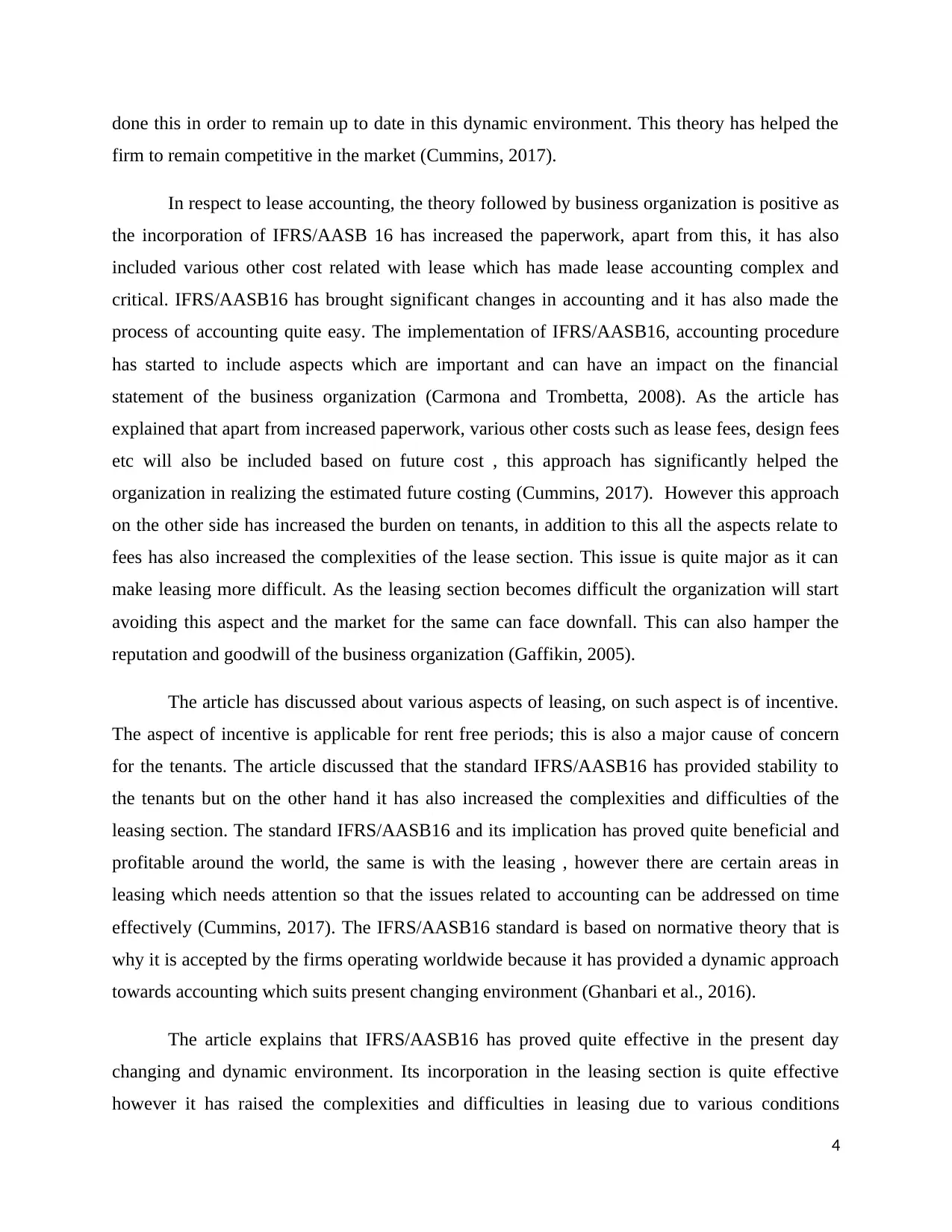
done this in order to remain up to date in this dynamic environment. This theory has helped the
firm to remain competitive in the market (Cummins, 2017).
In respect to lease accounting, the theory followed by business organization is positive as
the incorporation of IFRS/AASB 16 has increased the paperwork, apart from this, it has also
included various other cost related with lease which has made lease accounting complex and
critical. IFRS/AASB16 has brought significant changes in accounting and it has also made the
process of accounting quite easy. The implementation of IFRS/AASB16, accounting procedure
has started to include aspects which are important and can have an impact on the financial
statement of the business organization (Carmona and Trombetta, 2008). As the article has
explained that apart from increased paperwork, various other costs such as lease fees, design fees
etc will also be included based on future cost , this approach has significantly helped the
organization in realizing the estimated future costing (Cummins, 2017). However this approach
on the other side has increased the burden on tenants, in addition to this all the aspects relate to
fees has also increased the complexities of the lease section. This issue is quite major as it can
make leasing more difficult. As the leasing section becomes difficult the organization will start
avoiding this aspect and the market for the same can face downfall. This can also hamper the
reputation and goodwill of the business organization (Gaffikin, 2005).
The article has discussed about various aspects of leasing, on such aspect is of incentive.
The aspect of incentive is applicable for rent free periods; this is also a major cause of concern
for the tenants. The article discussed that the standard IFRS/AASB16 has provided stability to
the tenants but on the other hand it has also increased the complexities and difficulties of the
leasing section. The standard IFRS/AASB16 and its implication has proved quite beneficial and
profitable around the world, the same is with the leasing , however there are certain areas in
leasing which needs attention so that the issues related to accounting can be addressed on time
effectively (Cummins, 2017). The IFRS/AASB16 standard is based on normative theory that is
why it is accepted by the firms operating worldwide because it has provided a dynamic approach
towards accounting which suits present changing environment (Ghanbari et al., 2016).
The article explains that IFRS/AASB16 has proved quite effective in the present day
changing and dynamic environment. Its incorporation in the leasing section is quite effective
however it has raised the complexities and difficulties in leasing due to various conditions
4
firm to remain competitive in the market (Cummins, 2017).
In respect to lease accounting, the theory followed by business organization is positive as
the incorporation of IFRS/AASB 16 has increased the paperwork, apart from this, it has also
included various other cost related with lease which has made lease accounting complex and
critical. IFRS/AASB16 has brought significant changes in accounting and it has also made the
process of accounting quite easy. The implementation of IFRS/AASB16, accounting procedure
has started to include aspects which are important and can have an impact on the financial
statement of the business organization (Carmona and Trombetta, 2008). As the article has
explained that apart from increased paperwork, various other costs such as lease fees, design fees
etc will also be included based on future cost , this approach has significantly helped the
organization in realizing the estimated future costing (Cummins, 2017). However this approach
on the other side has increased the burden on tenants, in addition to this all the aspects relate to
fees has also increased the complexities of the lease section. This issue is quite major as it can
make leasing more difficult. As the leasing section becomes difficult the organization will start
avoiding this aspect and the market for the same can face downfall. This can also hamper the
reputation and goodwill of the business organization (Gaffikin, 2005).
The article has discussed about various aspects of leasing, on such aspect is of incentive.
The aspect of incentive is applicable for rent free periods; this is also a major cause of concern
for the tenants. The article discussed that the standard IFRS/AASB16 has provided stability to
the tenants but on the other hand it has also increased the complexities and difficulties of the
leasing section. The standard IFRS/AASB16 and its implication has proved quite beneficial and
profitable around the world, the same is with the leasing , however there are certain areas in
leasing which needs attention so that the issues related to accounting can be addressed on time
effectively (Cummins, 2017). The IFRS/AASB16 standard is based on normative theory that is
why it is accepted by the firms operating worldwide because it has provided a dynamic approach
towards accounting which suits present changing environment (Ghanbari et al., 2016).
The article explains that IFRS/AASB16 has proved quite effective in the present day
changing and dynamic environment. Its incorporation in the leasing section is quite effective
however it has raised the complexities and difficulties in leasing due to various conditions
4
Paraphrase This Document
Need a fresh take? Get an instant paraphrase of this document with our AI Paraphraser

(Cummins, 2017). The leasing document has become bulky and it has asked for various other
formalities. Leasing has become easing for tenants but the implementation of IFRS/AASB16 has
introduced various obligations for tenants which have resulted in increased difficulties for
tenants. With the implantation of IFRS/AASB16 in leasing the tenants now get to know about
the right of use of asset and also about the penalties that can be charged if the asset is damaged
by the tenants (Gaffikin, 2007).
In addition to this the article also explained that the aspect of gearing will also be affected
as the interest cover on capital will fall and loan taken will result in negotiation. The
implementation of IFRS/AASB16 can lead to increase in the indirect cost of the tenants. The
right of use of asset is also not the right given in favor of the tenants (Cummins, 2017). It
harnesses their right to use the asset for which they are paying rent to the landlord. Re-
measurement is another aspect which is included in leasing section, this aspect is more time
consuming and this changes the assets and liabilities at a variety of exchange rates which can
lead to fluctuation in the market and this will make it hard for tenants to purchase an asset on
lease. All these aspects can lay impact on the profit and loss structure of the organization (Pierre
and Guillaume, 2017).
The application of IFRS/AASB16 in leasing has certainly helped in rejuvenating this
aspect of business but on the other side its implementation has also created problems for tenants.
Apart from this IFRS/AASB16 has made it mandatory for business organsation to not to record
leasing in their financial statements. In general leasing holds for about 5-30 percent of profit and
loss statement of a business organsation (Cummins, 2017). The lack of rental expenses in
financial statement can lead to increase in the EBTIDA. The sales and leasing will lose their
effect as they will no longer remain the part of organization.
Thus, it can be inferred from the overall analysis of the article that the implementation of
IFRS/AASB16 has certainly reduced the complexities of accounting. It has brought homogeneity
in the accounting practices. The article has assessed IFRS/AASB16 and its implementation in the
leasing section of the business organization. IFRS/AASB16 has brought changes in the lease
section; in addition to this it has also introduced various issues to the same which are required to
be tackled properly and on time.
5
formalities. Leasing has become easing for tenants but the implementation of IFRS/AASB16 has
introduced various obligations for tenants which have resulted in increased difficulties for
tenants. With the implantation of IFRS/AASB16 in leasing the tenants now get to know about
the right of use of asset and also about the penalties that can be charged if the asset is damaged
by the tenants (Gaffikin, 2007).
In addition to this the article also explained that the aspect of gearing will also be affected
as the interest cover on capital will fall and loan taken will result in negotiation. The
implementation of IFRS/AASB16 can lead to increase in the indirect cost of the tenants. The
right of use of asset is also not the right given in favor of the tenants (Cummins, 2017). It
harnesses their right to use the asset for which they are paying rent to the landlord. Re-
measurement is another aspect which is included in leasing section, this aspect is more time
consuming and this changes the assets and liabilities at a variety of exchange rates which can
lead to fluctuation in the market and this will make it hard for tenants to purchase an asset on
lease. All these aspects can lay impact on the profit and loss structure of the organization (Pierre
and Guillaume, 2017).
The application of IFRS/AASB16 in leasing has certainly helped in rejuvenating this
aspect of business but on the other side its implementation has also created problems for tenants.
Apart from this IFRS/AASB16 has made it mandatory for business organsation to not to record
leasing in their financial statements. In general leasing holds for about 5-30 percent of profit and
loss statement of a business organsation (Cummins, 2017). The lack of rental expenses in
financial statement can lead to increase in the EBTIDA. The sales and leasing will lose their
effect as they will no longer remain the part of organization.
Thus, it can be inferred from the overall analysis of the article that the implementation of
IFRS/AASB16 has certainly reduced the complexities of accounting. It has brought homogeneity
in the accounting practices. The article has assessed IFRS/AASB16 and its implementation in the
leasing section of the business organization. IFRS/AASB16 has brought changes in the lease
section; in addition to this it has also introduced various issues to the same which are required to
be tackled properly and on time.
5
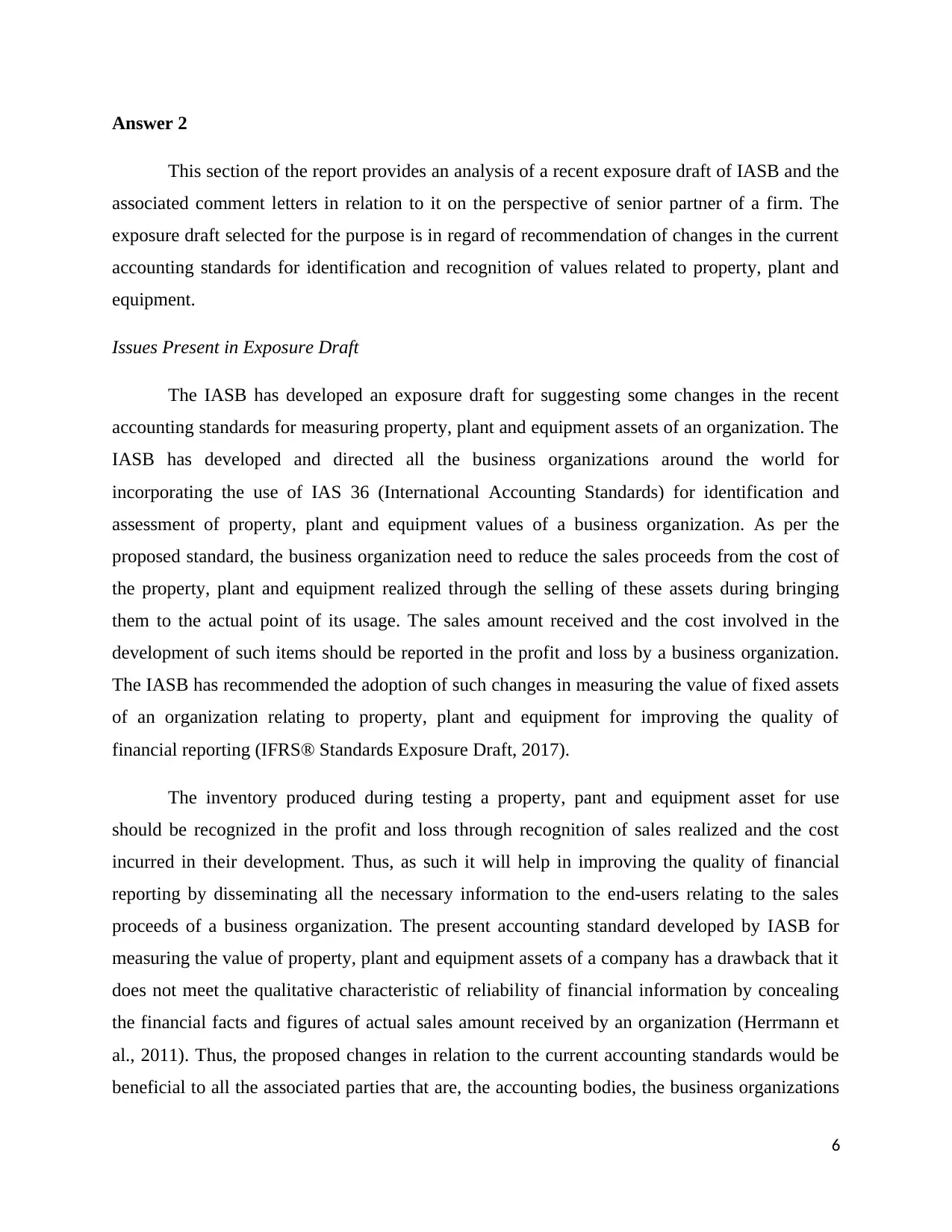
Answer 2
This section of the report provides an analysis of a recent exposure draft of IASB and the
associated comment letters in relation to it on the perspective of senior partner of a firm. The
exposure draft selected for the purpose is in regard of recommendation of changes in the current
accounting standards for identification and recognition of values related to property, plant and
equipment.
Issues Present in Exposure Draft
The IASB has developed an exposure draft for suggesting some changes in the recent
accounting standards for measuring property, plant and equipment assets of an organization. The
IASB has developed and directed all the business organizations around the world for
incorporating the use of IAS 36 (International Accounting Standards) for identification and
assessment of property, plant and equipment values of a business organization. As per the
proposed standard, the business organization need to reduce the sales proceeds from the cost of
the property, plant and equipment realized through the selling of these assets during bringing
them to the actual point of its usage. The sales amount received and the cost involved in the
development of such items should be reported in the profit and loss by a business organization.
The IASB has recommended the adoption of such changes in measuring the value of fixed assets
of an organization relating to property, plant and equipment for improving the quality of
financial reporting (IFRS® Standards Exposure Draft, 2017).
The inventory produced during testing a property, pant and equipment asset for use
should be recognized in the profit and loss through recognition of sales realized and the cost
incurred in their development. Thus, as such it will help in improving the quality of financial
reporting by disseminating all the necessary information to the end-users relating to the sales
proceeds of a business organization. The present accounting standard developed by IASB for
measuring the value of property, plant and equipment assets of a company has a drawback that it
does not meet the qualitative characteristic of reliability of financial information by concealing
the financial facts and figures of actual sales amount received by an organization (Herrmann et
al., 2011). Thus, the proposed changes in relation to the current accounting standards would be
beneficial to all the associated parties that are, the accounting bodies, the business organizations
6
This section of the report provides an analysis of a recent exposure draft of IASB and the
associated comment letters in relation to it on the perspective of senior partner of a firm. The
exposure draft selected for the purpose is in regard of recommendation of changes in the current
accounting standards for identification and recognition of values related to property, plant and
equipment.
Issues Present in Exposure Draft
The IASB has developed an exposure draft for suggesting some changes in the recent
accounting standards for measuring property, plant and equipment assets of an organization. The
IASB has developed and directed all the business organizations around the world for
incorporating the use of IAS 36 (International Accounting Standards) for identification and
assessment of property, plant and equipment values of a business organization. As per the
proposed standard, the business organization need to reduce the sales proceeds from the cost of
the property, plant and equipment realized through the selling of these assets during bringing
them to the actual point of its usage. The sales amount received and the cost involved in the
development of such items should be reported in the profit and loss by a business organization.
The IASB has recommended the adoption of such changes in measuring the value of fixed assets
of an organization relating to property, plant and equipment for improving the quality of
financial reporting (IFRS® Standards Exposure Draft, 2017).
The inventory produced during testing a property, pant and equipment asset for use
should be recognized in the profit and loss through recognition of sales realized and the cost
incurred in their development. Thus, as such it will help in improving the quality of financial
reporting by disseminating all the necessary information to the end-users relating to the sales
proceeds of a business organization. The present accounting standard developed by IASB for
measuring the value of property, plant and equipment assets of a company has a drawback that it
does not meet the qualitative characteristic of reliability of financial information by concealing
the financial facts and figures of actual sales amount received by an organization (Herrmann et
al., 2011). Thus, the proposed changes in relation to the current accounting standards would be
beneficial to all the associated parties that are, the accounting bodies, the business organizations
6

and the stakeholders. The adoption of IAS 36 by all the business corporations would help in
attaining a convergence of all the existing accounting standards related to measuring the value of
property, plant and equipment. The business organizations would benefit by improving the
transparency of their financial operations and thereby gaining the trust of all its stakeholders. The
stakeholders such as investors and creditors would benefit from receiving reliable and accurate
financial information and thus supporting their decision-making process relating to investment in
a particular business organization (Mande, 2014).
Application of Public Interest Theory for analyzing the behavior of regulator in introducing the
exposure draft
The theory of public interest is regarded to be an economic theory that is developed for
promoting the general welfare of people through correcting the inefficient market prices. The
theory is widely used by the accounting regulators in order to develop the accounting rules and
regulations that promote the welfare of all the stakeholders of a business organization. The
theory argues that economic markets are very inefficient and therefore need a regulatory
supervision for rectifying the inefficient practices that helps in promoting the interest of overall
societal members (Gaffikin, 2007). As such, the behavior of the regulatory body, that is IASB, in
proposing the changes in the IAS 36 standard for measuring the value of property, plant and
equipment. The current accounting standard in this context was not able to meet the needs of
end-users of financial information as such it does not provide actual information regarding the
sales income of business corporations. Therefore, as per the public interest theory the
intervention of the IASB is required for promoting the welfare of the end-users through
preparing changes in the accounting stand so that it provides reliable and relevant information
(IFRS® Standards Exposure Draft, 2017).
Outlining the comments on exposure draft by different respondents
The exposure draft developed by the IASB is open for public comments to gather the
perspective of different respondents in relation to the proposed changes in the accounting
standard for identifying the sales proceed arising before the actual use of property, plant and
equipment assets of an entity. As such, the comment letters developed in relation to the exposure
draft have been discussed in the present section as follows:
7
attaining a convergence of all the existing accounting standards related to measuring the value of
property, plant and equipment. The business organizations would benefit by improving the
transparency of their financial operations and thereby gaining the trust of all its stakeholders. The
stakeholders such as investors and creditors would benefit from receiving reliable and accurate
financial information and thus supporting their decision-making process relating to investment in
a particular business organization (Mande, 2014).
Application of Public Interest Theory for analyzing the behavior of regulator in introducing the
exposure draft
The theory of public interest is regarded to be an economic theory that is developed for
promoting the general welfare of people through correcting the inefficient market prices. The
theory is widely used by the accounting regulators in order to develop the accounting rules and
regulations that promote the welfare of all the stakeholders of a business organization. The
theory argues that economic markets are very inefficient and therefore need a regulatory
supervision for rectifying the inefficient practices that helps in promoting the interest of overall
societal members (Gaffikin, 2007). As such, the behavior of the regulatory body, that is IASB, in
proposing the changes in the IAS 36 standard for measuring the value of property, plant and
equipment. The current accounting standard in this context was not able to meet the needs of
end-users of financial information as such it does not provide actual information regarding the
sales income of business corporations. Therefore, as per the public interest theory the
intervention of the IASB is required for promoting the welfare of the end-users through
preparing changes in the accounting stand so that it provides reliable and relevant information
(IFRS® Standards Exposure Draft, 2017).
Outlining the comments on exposure draft by different respondents
The exposure draft developed by the IASB is open for public comments to gather the
perspective of different respondents in relation to the proposed changes in the accounting
standard for identifying the sales proceed arising before the actual use of property, plant and
equipment assets of an entity. As such, the comment letters developed in relation to the exposure
draft have been discussed in the present section as follows:
7
Secure Best Marks with AI Grader
Need help grading? Try our AI Grader for instant feedback on your assignments.

Comment Letter 1 from Brazilian Accounting Committee: The committee is involved
in the developing and implementing the accounting standards in the business
organizations of Brazil. As per the views of committee, the exposure draft proposed by
IASB on restricting the reduction of cost of any item of property, plant and equipment
from the sales amount realized through selling such items before their intended use. The
Brazilian committee has agreed with the proposed changes as the committee states that
the proposed changes covered with the views of accounting the income realized from
incidental operations in the profit and loss statement.
Comment Letter 2 from the AAT (Association of Accounting Technicians): In the
views of AAC, the recommend changes in the IAS 36 standards suggested by IASB are
fair and valid. The reason provided by the AAT for their agreement is that because some
industries such as manufacturing incurs high cost during asset testing before it is actually
available for use. Therefore, the AAT stated that any sales realized from the inventory
produced during asset testing before it is actually available for use do not have a major
impact on the cost value of assets. Thus, the sales realized from selling such items should
be recognized in the profit and loss account instead of reducing their amount from the
cost of assets.
Comment Letter 3 from the DRSC Berlin Accounting Body: The DRSC does not
agree with the proposed change sin the IAS 36 standard due to identification of the
following issues related with the changes:
1. There should be provided more clarity in relation to asset testing and the items produced
during such testing
2. The sales realized from selling the items produced during asset testing should only be
deduced from the cost
3. Also, there should be provide more disclosure in relation to the selection of deduction of
only sales revenue realized from selling items of asset testing
Comment Letter 4 from an individual names ‘Rhafael’ in Philippines’: As per the
views received from Rhafael, the changes proposed by IASB are fair enough as it
increases the relevancy of financial information presented to the end-users. The
recommend changes will resolve the conclusion reading the treatment of sales proceeds
realized from selling the items produced during asset testing by a business organization.
8
in the developing and implementing the accounting standards in the business
organizations of Brazil. As per the views of committee, the exposure draft proposed by
IASB on restricting the reduction of cost of any item of property, plant and equipment
from the sales amount realized through selling such items before their intended use. The
Brazilian committee has agreed with the proposed changes as the committee states that
the proposed changes covered with the views of accounting the income realized from
incidental operations in the profit and loss statement.
Comment Letter 2 from the AAT (Association of Accounting Technicians): In the
views of AAC, the recommend changes in the IAS 36 standards suggested by IASB are
fair and valid. The reason provided by the AAT for their agreement is that because some
industries such as manufacturing incurs high cost during asset testing before it is actually
available for use. Therefore, the AAT stated that any sales realized from the inventory
produced during asset testing before it is actually available for use do not have a major
impact on the cost value of assets. Thus, the sales realized from selling such items should
be recognized in the profit and loss account instead of reducing their amount from the
cost of assets.
Comment Letter 3 from the DRSC Berlin Accounting Body: The DRSC does not
agree with the proposed change sin the IAS 36 standard due to identification of the
following issues related with the changes:
1. There should be provided more clarity in relation to asset testing and the items produced
during such testing
2. The sales realized from selling the items produced during asset testing should only be
deduced from the cost
3. Also, there should be provide more disclosure in relation to the selection of deduction of
only sales revenue realized from selling items of asset testing
Comment Letter 4 from an individual names ‘Rhafael’ in Philippines’: As per the
views received from Rhafael, the changes proposed by IASB are fair enough as it
increases the relevancy of financial information presented to the end-users. The
recommend changes will resolve the conclusion reading the treatment of sales proceeds
realized from selling the items produced during asset testing by a business organization.
8
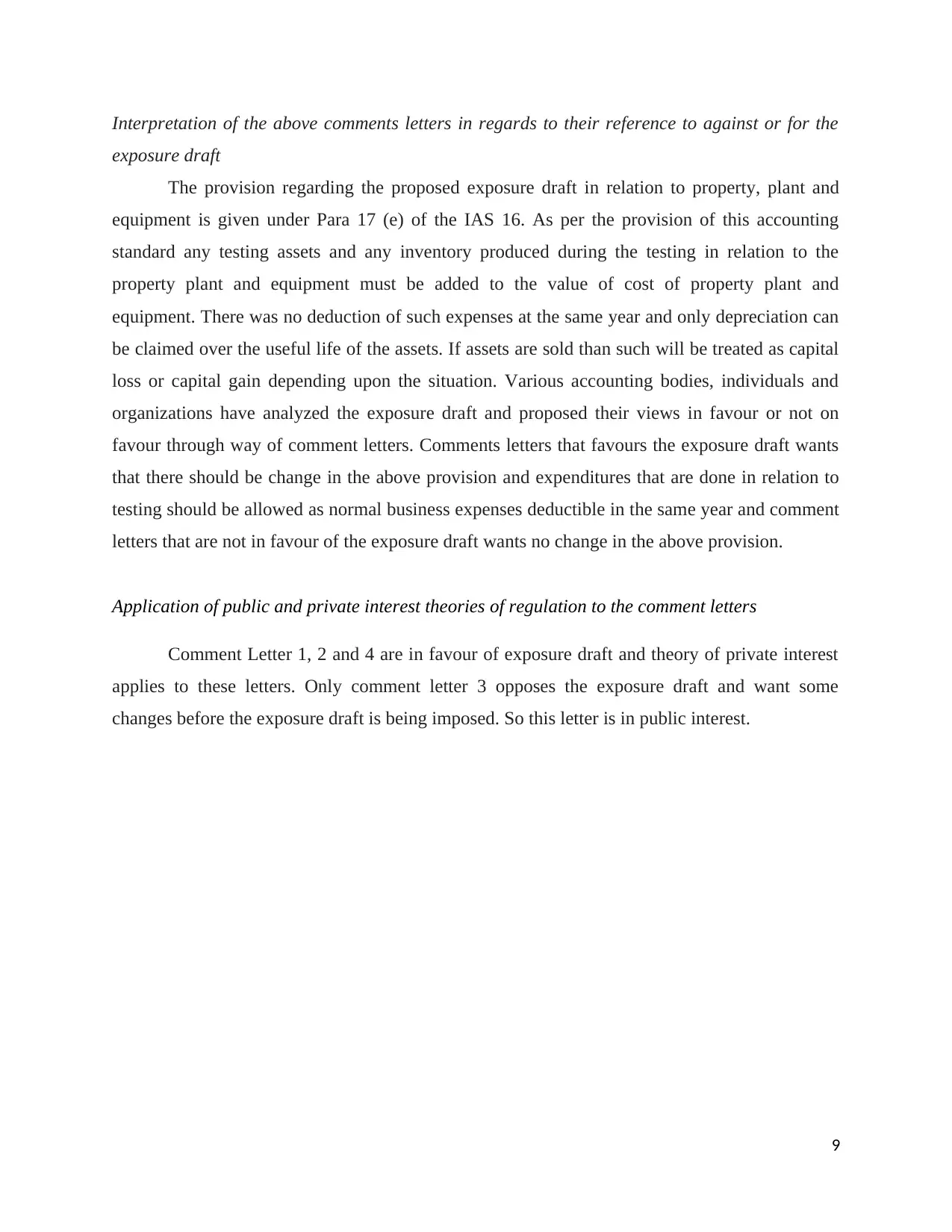
Interpretation of the above comments letters in regards to their reference to against or for the
exposure draft
The provision regarding the proposed exposure draft in relation to property, plant and
equipment is given under Para 17 (e) of the IAS 16. As per the provision of this accounting
standard any testing assets and any inventory produced during the testing in relation to the
property plant and equipment must be added to the value of cost of property plant and
equipment. There was no deduction of such expenses at the same year and only depreciation can
be claimed over the useful life of the assets. If assets are sold than such will be treated as capital
loss or capital gain depending upon the situation. Various accounting bodies, individuals and
organizations have analyzed the exposure draft and proposed their views in favour or not on
favour through way of comment letters. Comments letters that favours the exposure draft wants
that there should be change in the above provision and expenditures that are done in relation to
testing should be allowed as normal business expenses deductible in the same year and comment
letters that are not in favour of the exposure draft wants no change in the above provision.
Application of public and private interest theories of regulation to the comment letters
Comment Letter 1, 2 and 4 are in favour of exposure draft and theory of private interest
applies to these letters. Only comment letter 3 opposes the exposure draft and want some
changes before the exposure draft is being imposed. So this letter is in public interest.
9
exposure draft
The provision regarding the proposed exposure draft in relation to property, plant and
equipment is given under Para 17 (e) of the IAS 16. As per the provision of this accounting
standard any testing assets and any inventory produced during the testing in relation to the
property plant and equipment must be added to the value of cost of property plant and
equipment. There was no deduction of such expenses at the same year and only depreciation can
be claimed over the useful life of the assets. If assets are sold than such will be treated as capital
loss or capital gain depending upon the situation. Various accounting bodies, individuals and
organizations have analyzed the exposure draft and proposed their views in favour or not on
favour through way of comment letters. Comments letters that favours the exposure draft wants
that there should be change in the above provision and expenditures that are done in relation to
testing should be allowed as normal business expenses deductible in the same year and comment
letters that are not in favour of the exposure draft wants no change in the above provision.
Application of public and private interest theories of regulation to the comment letters
Comment Letter 1, 2 and 4 are in favour of exposure draft and theory of private interest
applies to these letters. Only comment letter 3 opposes the exposure draft and want some
changes before the exposure draft is being imposed. So this letter is in public interest.
9
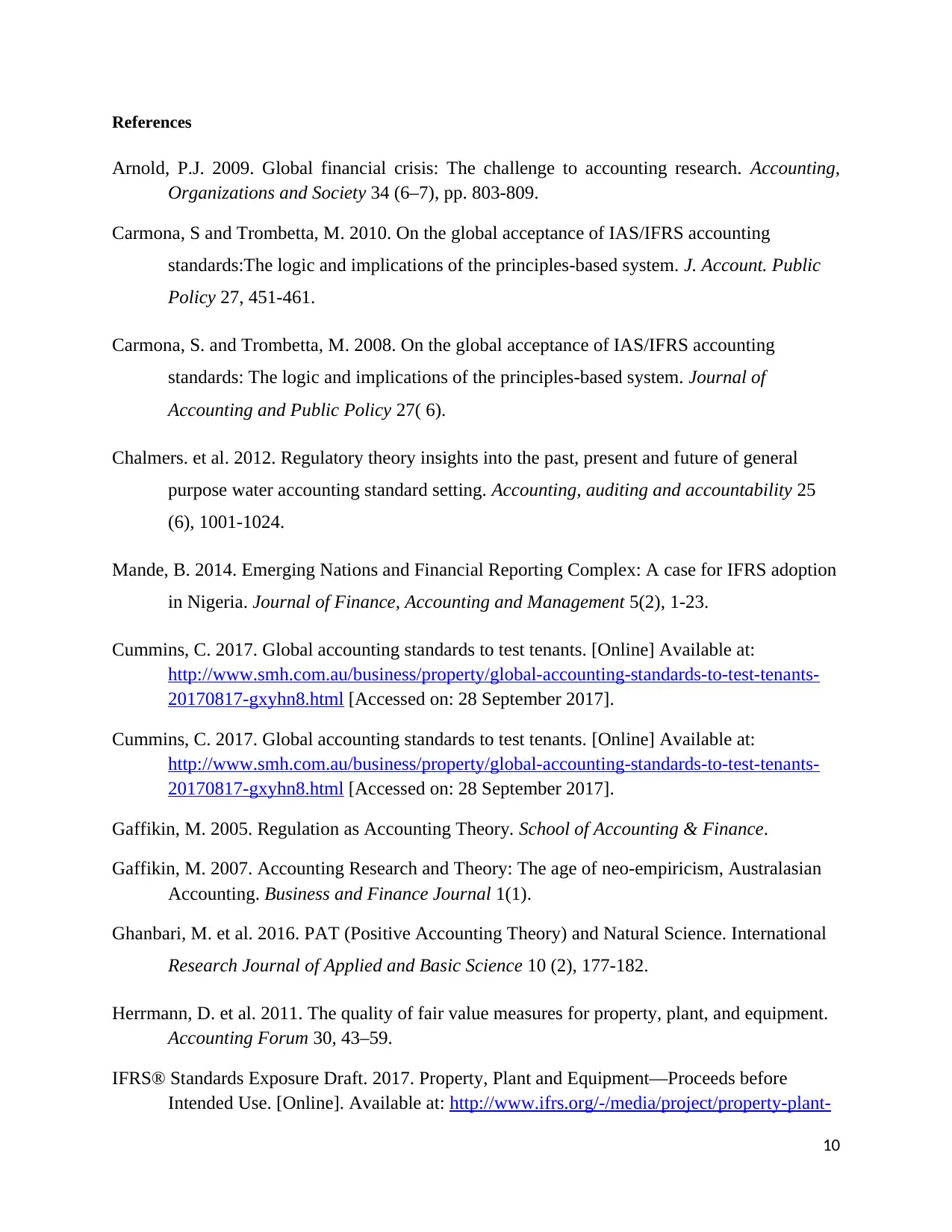
References
Arnold, P.J. 2009. Global financial crisis: The challenge to accounting research. Accounting,
Organizations and Society 34 (6–7), pp. 803-809.
Carmona, S and Trombetta, M. 2010. On the global acceptance of IAS/IFRS accounting
standards:The logic and implications of the principles-based system. J. Account. Public
Policy 27, 451-461.
Carmona, S. and Trombetta, M. 2008. On the global acceptance of IAS/IFRS accounting
standards: The logic and implications of the principles-based system. Journal of
Accounting and Public Policy 27( 6).
Chalmers. et al. 2012. Regulatory theory insights into the past, present and future of general
purpose water accounting standard setting. Accounting, auditing and accountability 25
(6), 1001-1024.
Mande, B. 2014. Emerging Nations and Financial Reporting Complex: A case for IFRS adoption
in Nigeria. Journal of Finance, Accounting and Management 5(2), 1-23.
Cummins, C. 2017. Global accounting standards to test tenants. [Online] Available at:
http://www.smh.com.au/business/property/global-accounting-standards-to-test-tenants-
20170817-gxyhn8.html [Accessed on: 28 September 2017].
Cummins, C. 2017. Global accounting standards to test tenants. [Online] Available at:
http://www.smh.com.au/business/property/global-accounting-standards-to-test-tenants-
20170817-gxyhn8.html [Accessed on: 28 September 2017].
Gaffikin, M. 2005. Regulation as Accounting Theory. School of Accounting & Finance.
Gaffikin, M. 2007. Accounting Research and Theory: The age of neo-empiricism, Australasian
Accounting. Business and Finance Journal 1(1).
Ghanbari, M. et al. 2016. PAT (Positive Accounting Theory) and Natural Science. International
Research Journal of Applied and Basic Science 10 (2), 177-182.
Herrmann, D. et al. 2011. The quality of fair value measures for property, plant, and equipment.
Accounting Forum 30, 43–59.
IFRS® Standards Exposure Draft. 2017. Property, Plant and Equipment—Proceeds before
Intended Use. [Online]. Available at: http://www.ifrs.org/-/media/project/property-plant-
10
Arnold, P.J. 2009. Global financial crisis: The challenge to accounting research. Accounting,
Organizations and Society 34 (6–7), pp. 803-809.
Carmona, S and Trombetta, M. 2010. On the global acceptance of IAS/IFRS accounting
standards:The logic and implications of the principles-based system. J. Account. Public
Policy 27, 451-461.
Carmona, S. and Trombetta, M. 2008. On the global acceptance of IAS/IFRS accounting
standards: The logic and implications of the principles-based system. Journal of
Accounting and Public Policy 27( 6).
Chalmers. et al. 2012. Regulatory theory insights into the past, present and future of general
purpose water accounting standard setting. Accounting, auditing and accountability 25
(6), 1001-1024.
Mande, B. 2014. Emerging Nations and Financial Reporting Complex: A case for IFRS adoption
in Nigeria. Journal of Finance, Accounting and Management 5(2), 1-23.
Cummins, C. 2017. Global accounting standards to test tenants. [Online] Available at:
http://www.smh.com.au/business/property/global-accounting-standards-to-test-tenants-
20170817-gxyhn8.html [Accessed on: 28 September 2017].
Cummins, C. 2017. Global accounting standards to test tenants. [Online] Available at:
http://www.smh.com.au/business/property/global-accounting-standards-to-test-tenants-
20170817-gxyhn8.html [Accessed on: 28 September 2017].
Gaffikin, M. 2005. Regulation as Accounting Theory. School of Accounting & Finance.
Gaffikin, M. 2007. Accounting Research and Theory: The age of neo-empiricism, Australasian
Accounting. Business and Finance Journal 1(1).
Ghanbari, M. et al. 2016. PAT (Positive Accounting Theory) and Natural Science. International
Research Journal of Applied and Basic Science 10 (2), 177-182.
Herrmann, D. et al. 2011. The quality of fair value measures for property, plant, and equipment.
Accounting Forum 30, 43–59.
IFRS® Standards Exposure Draft. 2017. Property, Plant and Equipment—Proceeds before
Intended Use. [Online]. Available at: http://www.ifrs.org/-/media/project/property-plant-
10
Paraphrase This Document
Need a fresh take? Get an instant paraphrase of this document with our AI Paraphraser
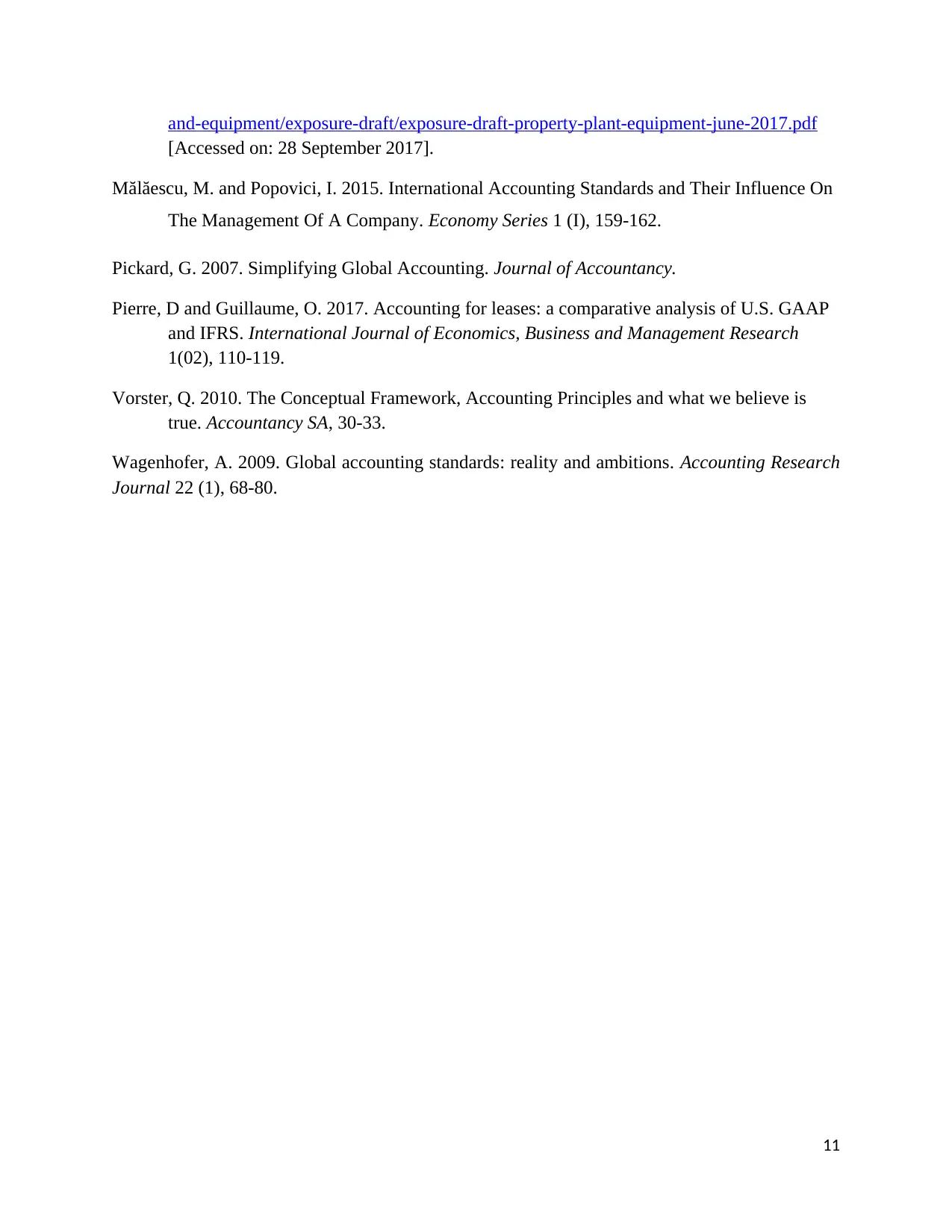
and-equipment/exposure-draft/exposure-draft-property-plant-equipment-june-2017.pdf
[Accessed on: 28 September 2017].
Mălăescu, M. and Popovici, I. 2015. International Accounting Standards and Their Influence On
The Management Of A Company. Economy Series 1 (I), 159-162.
Pickard, G. 2007. Simplifying Global Accounting. Journal of Accountancy.
Pierre, D and Guillaume, O. 2017. Accounting for leases: a comparative analysis of U.S. GAAP
and IFRS. International Journal of Economics, Business and Management Research
1(02), 110-119.
Vorster, Q. 2010. The Conceptual Framework, Accounting Principles and what we believe is
true. Accountancy SA, 30-33.
Wagenhofer, A. 2009. Global accounting standards: reality and ambitions. Accounting Research
Journal 22 (1), 68-80.
11
[Accessed on: 28 September 2017].
Mălăescu, M. and Popovici, I. 2015. International Accounting Standards and Their Influence On
The Management Of A Company. Economy Series 1 (I), 159-162.
Pickard, G. 2007. Simplifying Global Accounting. Journal of Accountancy.
Pierre, D and Guillaume, O. 2017. Accounting for leases: a comparative analysis of U.S. GAAP
and IFRS. International Journal of Economics, Business and Management Research
1(02), 110-119.
Vorster, Q. 2010. The Conceptual Framework, Accounting Principles and what we believe is
true. Accountancy SA, 30-33.
Wagenhofer, A. 2009. Global accounting standards: reality and ambitions. Accounting Research
Journal 22 (1), 68-80.
11
1 out of 11
![[object Object]](/_next/static/media/star-bottom.7253800d.svg)





